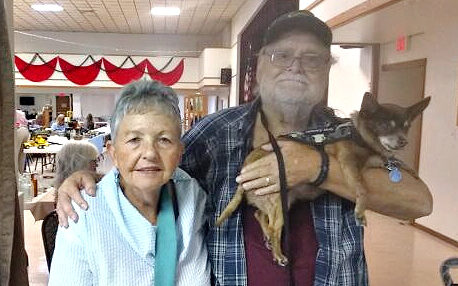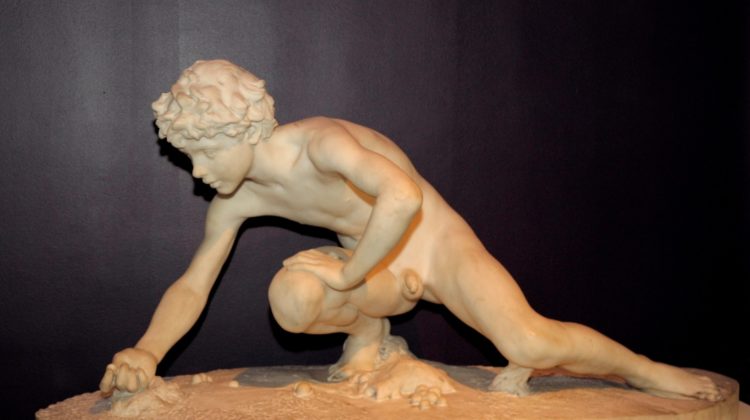
Joueur de Billes (Marble Player)[1]
Co-Author: Wendy Leyn, Zandvoorde (Zonnebeke), West Flanders, Belgium
Editors: It is with deep sadness that we tell you that our dear friend Wendy Leyn has died due to heart failure. Wendy was a friend, a colleague, and one of the most dedicated and tenacious researchers that it has been our pleasure to work with. Wendy is missed and the marble community has lost a valued friend.
Early this summer the three of us started researching an idea which is of importance to us. Fundamentally, we wanted to learn more about the artifacts and stories of marble play. Have marbles and marble play spread over time from culture to culture, or did each society spontaneously start to play marbles with few cross-cultural influences?
We knew that children have played marbles since Paleolithic times. And when we started researching we discovered many other ideas to study. For example, are marbles known in all cultures worldwide? Do all countries have a history and tradition of marble play?
Where Did We Look?

http://www.freeworldmaps.net/europe/political.html 10/23/2023
Our research led us to some remarkable places and we developed three stories which sum up our findings so far. These stories are: “Has Nikolai Lost His Marbles?”, “Searching For Nikolai’s Marbles”, and “Nikolai’s Marbles: Analytic Comments.” We received a number of replies from researchers and specialists in many fields worldwide regarding the stories. For example, there is this: “This is indeed a very original angle into Russian history and an impressively deep investigation!”[2]
While we were satisfied with our collective efforts so far, we discovered that the streams of information did overflow. We constantly found small details, nuggets of information which, while fortuitous to come across, were not enough to frame a story around. And yet again and again we all agreed that the information was just too good and too pertinent not to share with you.
So, we started to collect these snippets of information about marble artifacts, marbles, and marble play and have bundled them loosely to create this post. Many of these bits and pieces are from academics, researchers, and professors who were or who are still in sensitive positions. While we provide all of the details which we can about each individual, in some cases we have to revert to using only their initials or a few other pertinent details. We do, of course, have full contact information in our electronic and text files.
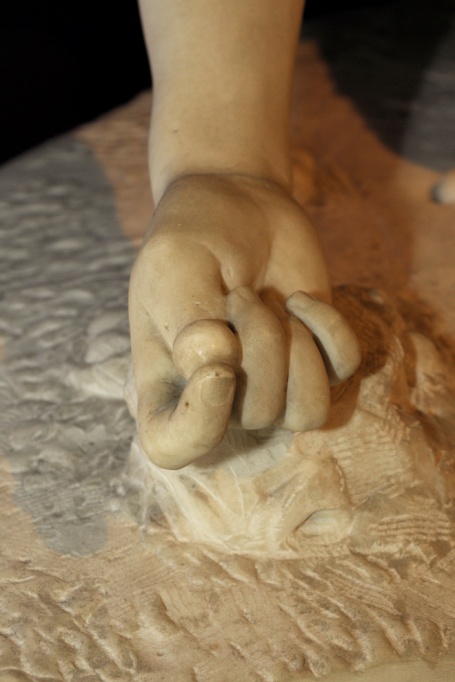
Joueur de Billes
Wendy found this gorgeous white marble statue while researching online. Just study the detail in the boy’s hand! It does look alive! The sculptor was Joseph-Louis Enderlin and today the statue is in the Musée des Beaux-arts de Reims chez Ville de Reims in France. The sculpture won the Gran Prix de Florence at the Salon in 1880. Full attribution for our use of these images is provided at the bottom of page one.
Joseph-Louis Enderlin
Joseph-Louis Enderlin was born the youngest of five children in Aesch, Switzerland. He was born in 1851 and he died in 1940. The artist’s father, Louis Xavier Enderlin, was also a sculptor.
Enderlin moved to Paris in 1872 and studied under sculptor Auguste Dumont at the École des Beaux-Arts. He later became a member of the Société des Artistes Français and exhibited his work at the Salon de Paris.[3]
We have never seen fine art like this showing a child playing marbles. Have you? It is an incredible find and just one of many which we have found while researching related topics. Here are some more snippets to think about.
Grete Lillehammer & Povilas Blaževičius
In response to our question about Russian marbles, we received an email from Professor Grete Lillehammer. Her email was received on the 23rd of September. She is Professor Emerita at the Museum of Archeology, University of Stavanger in Norway. Dr. Lillehammer told us in part:
“…your questions started me to think that Russian toys, such as marbles, could be regarded from the perspective of long duration, and therefore part of traditional games and play in Russian culture.
I know only one person that may help you further on the way. That is the Lithuanian archaeologist Povilas Blaževičius at the Institute of Baltic Sea Region, History and Archaeology, Faculty of Humanities, Klaipėda University [Lithuanian Republic[4]]. …. He attended and gave a speach at a conference in Stavanger, Norway in 2008, and which I organized on behalf SCCIP (Society for the Study of Childhood in the Past).
The conference was published (Lillehammer, G. (ed. Socialisation. Recent Research on Childhood and Children in the Past) in 2010. He worked on children’s amusement between the 14th-17th centuries.”
And that is how we learned about Povilas Blaževičius and his work on the archaeology of toys and games in Europe. His email reads in part: “…. According to archaeological data, marbles have definitely been popular in Lithuania since the Middle Ages. Knowledge of the 19th and 20th centuries is scarce, but it is clear that they were more widespread in the western part of the country (then part of Prussia).”
Dr. Blaževičius also referred us to his work in academia.edu https://www.academia.edu/ where he has “published the sparse archaeological material in a monograph on the history of Lithuanian toys.”
Academia.edu
You do have to subscribe to use Academia.edu, but in our experience it is well worth it. The service reports that “Academia is a platform for sharing academic research. Academics have uploaded 47 million papers, and 79 million academics, professionals, and students read papers on Academia every month.”[5] Critically for our work the service does provide an effective and fast translation service. The papers online can be downloaded in .pdf format.
Some of Dr. Blaževičius’ Studies
We studied the papers which Dr. Blaževičius has published and posted to Academia.edu. We downloaded and studied “Toys as a reflection of a player’s social status”[6] (Child and childhood.indd). Here are some of his more pertinent observations for this story.
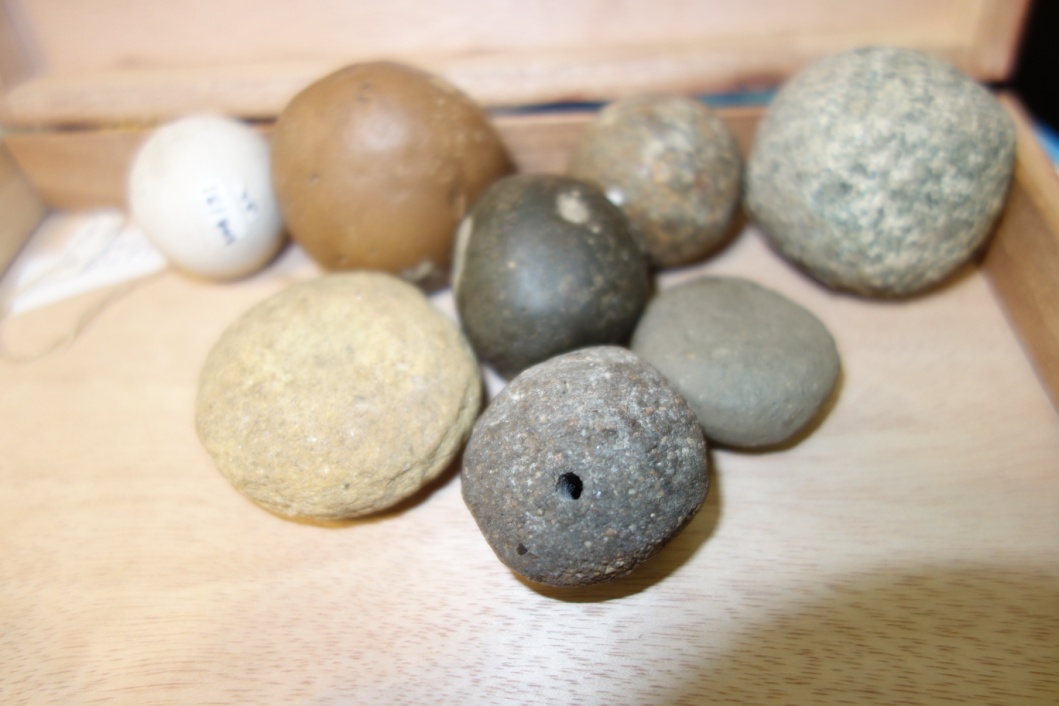
Photograph by C. Joanne Garrett: Illustrative of the games discussed by Professor Blaževičius
“…Toys and games are a universal phenomenon which swiftly and easily overcomes national, linguistic, political … barriers and spreads throughout the world thus creating general cultural features ….” He notes that in Europe, “…most numerous game-related artefacts originate in the Late Middle Ages….”
“Toys and games are a trans-cultural phenomenon by their very nature, as they tend to spread easily from the country of origin to other regions.”
About 15th – 18th Century Marbles
“The comparison of marbles of the 15th – 18th centuries reveals significant qualitative and, in turn, probable price differences. All of them are approximately 1 – 2 cm in diameter, but made from different materials: clay, glass, bone, or stone.” Figure 6 in his study shows three of these antique marbles which were made of both clay and glass.
Bone Marbles & Pig Knuckles?
We were amazed to see bone listed as a source of marbles. Larry recently found a hog knuckle bone at an historical house site in Mobile, Alabama. It was probably used as a type die. And, while not his specialty, he did study bone morphology and bone identification while a volunteer in a university archaeology and field study program for over five years.
In archaeology digs, large mammal bone is hollow because people have historically found the marrow to be extremely nourishing. It was generally carefully removed. So, even with cow, hog, or wild harvested animals there is little solid bone left to make marbles.
Professor Blaževičius discusses how bone was used to make skittles and skates. His Figure 5 shows a number of such toys. On the other hand, he does not give us details of how bone marbles were made. So, we are a bit perplexed about bone marbles.
Curling?
The last thing that we will report from this study, which, as we noted can be downloaded in full, is this comment. “The [15th – 18th century] game of marbles was similar to modern curling.” We know nothing about curling, but cannot visualize how that game relates to marbles. “Curling is a team sport, played on ice, where two teams take it in turns to slide stones made of granite towards a target – known as a House.” [7] While we are uncertain, we imagine that Professor Blaževičius is referencing some type bowl-holey marble play.
Wendy knows how to curl! He plays monthly a form of interior curling at Dorpspunt Zandvoorde.
This entire article is well worth downloading and reading. It is a significant contribution to the literature about the cross-cultural nature of toys and games including marbles. And it underscores the international importance of children’s games and play as one critical form of cultural bonding. It also illustrates that marbles and marble play have historically served as cross-cultural social agents.
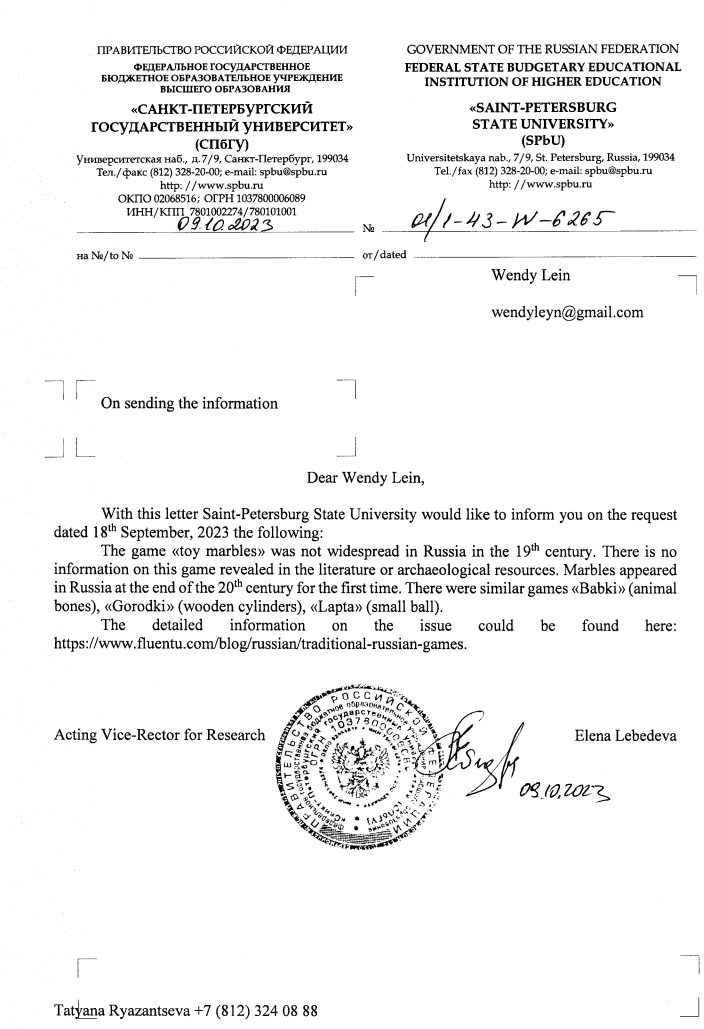
Seeing is Believing
We include this document to give you some appreciation of the formality of the Vice-Rector’s (of the Saint Petersburg University) response!
Because marble artifacts and marble play are historically trans-cultural phenomena and marbles and marble play have historically served as cross-cultural social agents, this document from Saint Petersburg State University is even more remarkable. The University was founded in 1724 and “…from the beginning has had a focus on fundamental research in science, engineering and humanities.”[8]
Not in Russia?
Note that Dr. Lebedeva reports that the game of marbles was not widespread in Russia in the 19th century and that there is no record of marble play or marble artifacts in the archaeological literature. One of the more startling reports is that
“marbles appeared in Russia at the end of the 20th century for the first time”. The end of the 20th century!
Dr. Lebedeva mentions the historical game of Babki using animal bones. “’Babki’ is an old Russian game in which the bones of hoofed joint of animals (cows, pigs, sheep) were used as dice. A large number of children could take part in this game. The playing field was drawn on a flat surface; the bones, which had to be knocked out with a bat, were placed in a special window in a certain order. This fascinating game improved the skill of throwing, as well as developed strength, speed, and attention.”[9]
Babki did not involve marble play, but we were reminded of Blaževičius’ study where he noted marbles made of bone in the historical and archaeological record. Again, we raise the question: if large mammal bones were used in Russia to make dice then why did they not also carve and play some type marble game?
Finally, Professor Lebedeva mentions Lapta. The game is old! It dates to the 10th century and is still played today. It is played with a ball and bat on a rectangular field.
Olga Grankina Vladislavovna
Moscow is about 440 miles from Saint Petersburg. The Museum of Russia, which is a museum of Russian history, is in Moscow. In mid-October Ms. Olga Grankina, who serves as senior research associate at the Museum, emailed Wendy that “unfortunately, the enormous collection of the State Historical Museum does not contain any items dealing with marbles and marble playing tradition.”
Further confirmation that regarding marble play Russian society is apparently singular in international cultural history: they have few marbles today, and those are imported from Mexico, and they have had no toy marble artifacts nor any history of marble play in the past.
Belearus & Professor Palina Kurlovich; Archaeologist, Belarusian State University, Minsk[10]
In late September Dr. Kurlovich responded to Wendy’s inquiry about marbles in Russia” “I am not a specialist in this topic, but I know that there are some findings of clay marbles on the territory of Belarus in the 16th-17th centuries. When I was writing my PhD-thesis about glass in the 16th-19th centuries on the territory of Northern and Central Belarus, I found some glass marbles in Vicebsk. You can see these marbles on the photos from the book Колединский, Л.В. Верхний замок Витебска (IX–XVIII вв.). – Гродно: ЮрсаПринт, 2021. – 632 с. Koledinsky, L.V. Upper castle of Vitebsk (IX–XVIII centuries). – Grodno: YursaPrint, 2021. – 632 p.
Vitebsk
It is just less than 400 miles from Vitebsk to Saint Petersburg and some 400 miles to Moscow. So, while we have switched cities and now countries in our explorations of marbles, all of the places mentioned so far are clustered relatively close together.
Vitebsk is celebrated in Belarus as being over 1000 years old.
“Vitebsk Oblast is the birthplace of Belarusian statehood. In the 9th century this region saw the establishment of the first state formation in the Belarusian land – Principality of Polotsk.
Founded in 862 on the banks of the Western Dvina River, the city of Polotsk is the most ancient city of Belarus. Its long history was marked by a heroic struggle against the invasions of the Vikings, crusaders and a great many of other conquerors.”[11]
Yes, there is evidence of Viking occupation in Belarus!
Upper Castle of Vitebsk
Dr. Kurlovich’s scientific paper was published in the monograph Upper Castle of Vitebsk (IX–XVIII) centuries. This book, by L.V. Koledinsky, summarizes the extensive archaeology of the castle from 1977 – 1993. It also examines the laboratory studies of artifacts from the excavations.
Photographs
We regret that we have been unable to find a copy of Dr. Kurlovic’s Ph.D. dissertation online.
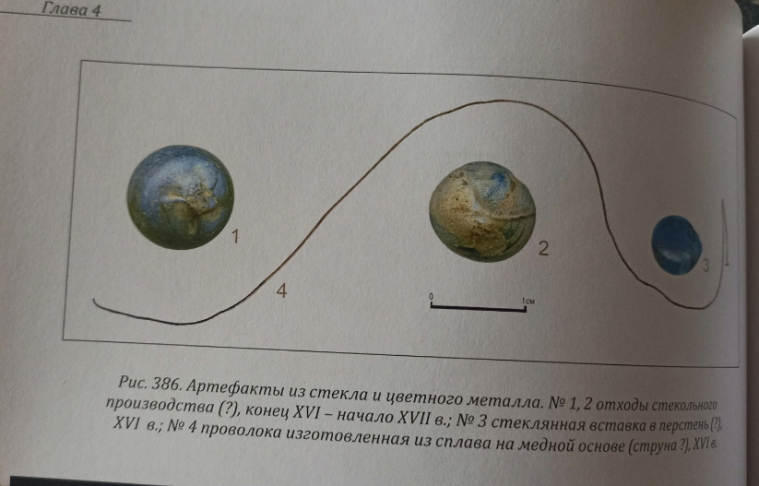
However, she was kind enough to send photographs of the glass marbles, clay, and dolomite marbles which are illustrated in her scientific study of her excavation in Vitebsk. We believe that these marbles date to the end of the 16th century. Note that her study was published in L.V. Koledinsky’s monograph Upper Castle of Vitebsk (IX–XVIII) Centuries.
Since we were unable to translate the Russian descriptions of Dr. Kurolvich’s marbles we wrote to ask if she would translate them for us. She was very kind and these are her translations: “Img. 386. Glass and non-ferrous metal artifacts. N 1, 2 – glass production waste (?), end of the 16th – beginning of the 17th century; N 3 – glass insert into ring (?), 16th century; N 4 – wire, made from copper alloy (string?), XVI century.”
Guta Glass Production in Belarus
This idea about “…glass production waste” is an important and recurring topic in Dr. Kurolvich’s archaeological excavations and studies. If you visit Google Scholar online then you will see a long list of her archaeological papers[12]. You will also notice that a number of the papers have the word “gut” in the title.
What really got our attention in her articles is the idea that “gut” and hütte, as in our story The Lauschaer Glashütte and the Origins of Modern Glass Marbles are, while not translated exactly alike, very similar when expressed in the archeology and history of both. Kurolvich explains that guta glass production is a “patrimonial manufactory for the production of glass.”
This production of glass jugs, bottles, miniature vessels, beakers, and window glass required the same fundamental elements in both Germany and in Belarus. Sand, abundant wood, and specialized glass production and technologies were required in both the guta & hütte.
A Glass Marble Migration?
But what really got our attention in an article by Kurlovich and Chubur[13] is that historically in Belarus there has been a “…gradual advancement of gut business from west to east…and the subsequent formation of a powerful production core in the Ukranian lands on the Dneiper left bank….”
When we marble collectors think of small family glass plants we always think of marble cullet. Many of us have dug abandoned marble and glass sites. We know that when we find shards of glass plates, bottles, and jars on a marble making site that it is because the marble makers used scrap glass from other glass houses to run marbles.
We Wondered….
Here is our question: since glass marbles and glass scrap were both excavated in Vitebsk, Belarus, does this then mean that marbles, which we have learned were a viable part of history in this region, also traveled along with the other gut glass from the West (ie Germany) to the East (Russia, Ukraine, Belarus)? We also wonder if there is archaeological evidence of this migration of marbles.
In an October email follow up to our question about glass migration via the Gut, Dr. Kurlovich wrote us that she had only found marbles in Vicebsk. However, she also wrote: “…in my opinion these small items can be found in other towns somewhere. The German glashutte had significant influence in the gut production in Belarus.”
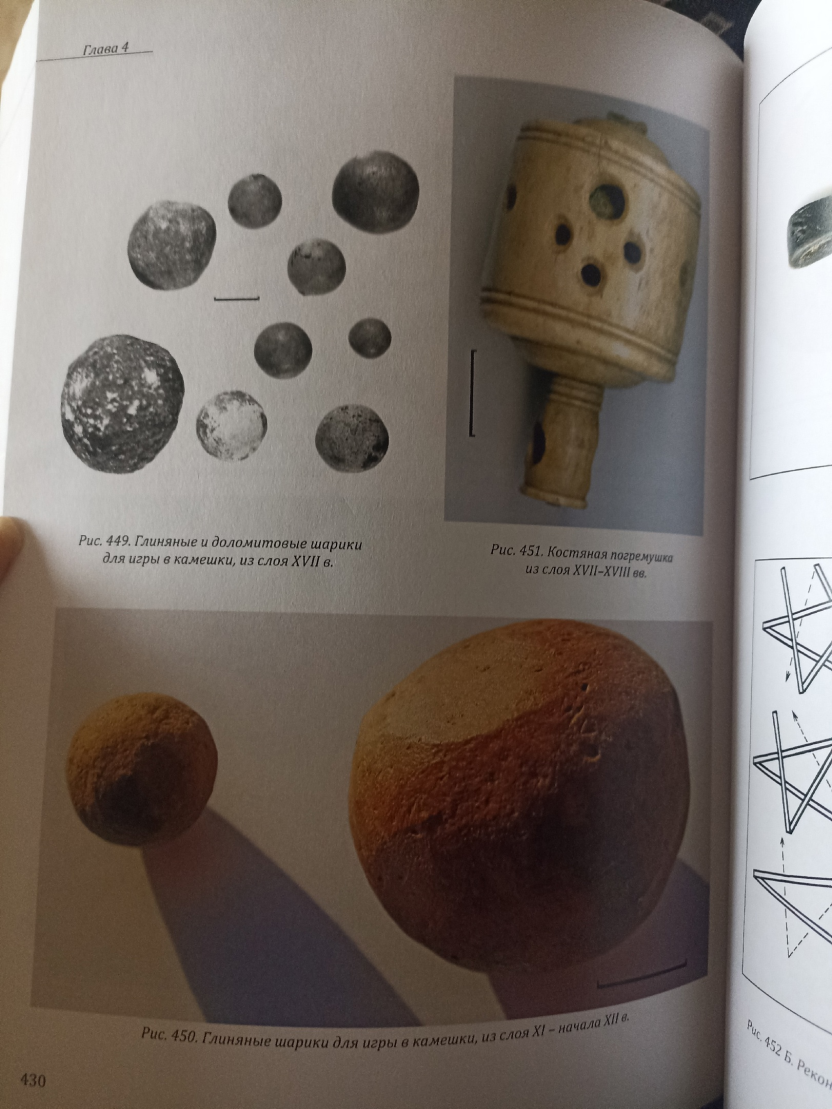
More image translation description and annotation from Dr. Kurlovich:
Img. 449. Clay and dolomite balls for playing marbles (?) (small stones) from the 17th century layer.
Img. 450. Clay balls for playing marbles (?) (small stones) from the 11th – beginning of the 12th century layer.
And from her email accompanying her translation:
“These images are published in the book about Vicebsk (Belarusian city) in the 9th – 18th centuries. Information in this book is based on the results of excavation of belarusian archaeologist Leonid Koledinsky mainly in 1980-s. He is the author of this book. When he wrote his book, we discussed some issues about glass artifacts. The most difficult problem for me was interpretation of small glass balls (Img. 386 above). I thought that these findings could be used for games, but I didn’t found any proofs. I didn’t know also the context of these items (the methods of excavation in 1980-s didn’t provide precise fixation). So, I interpreted it like glass production waste, because similar drops of glass I found during my excavation in Ilya glass manufactory[14] (huta) of the 18th century.”
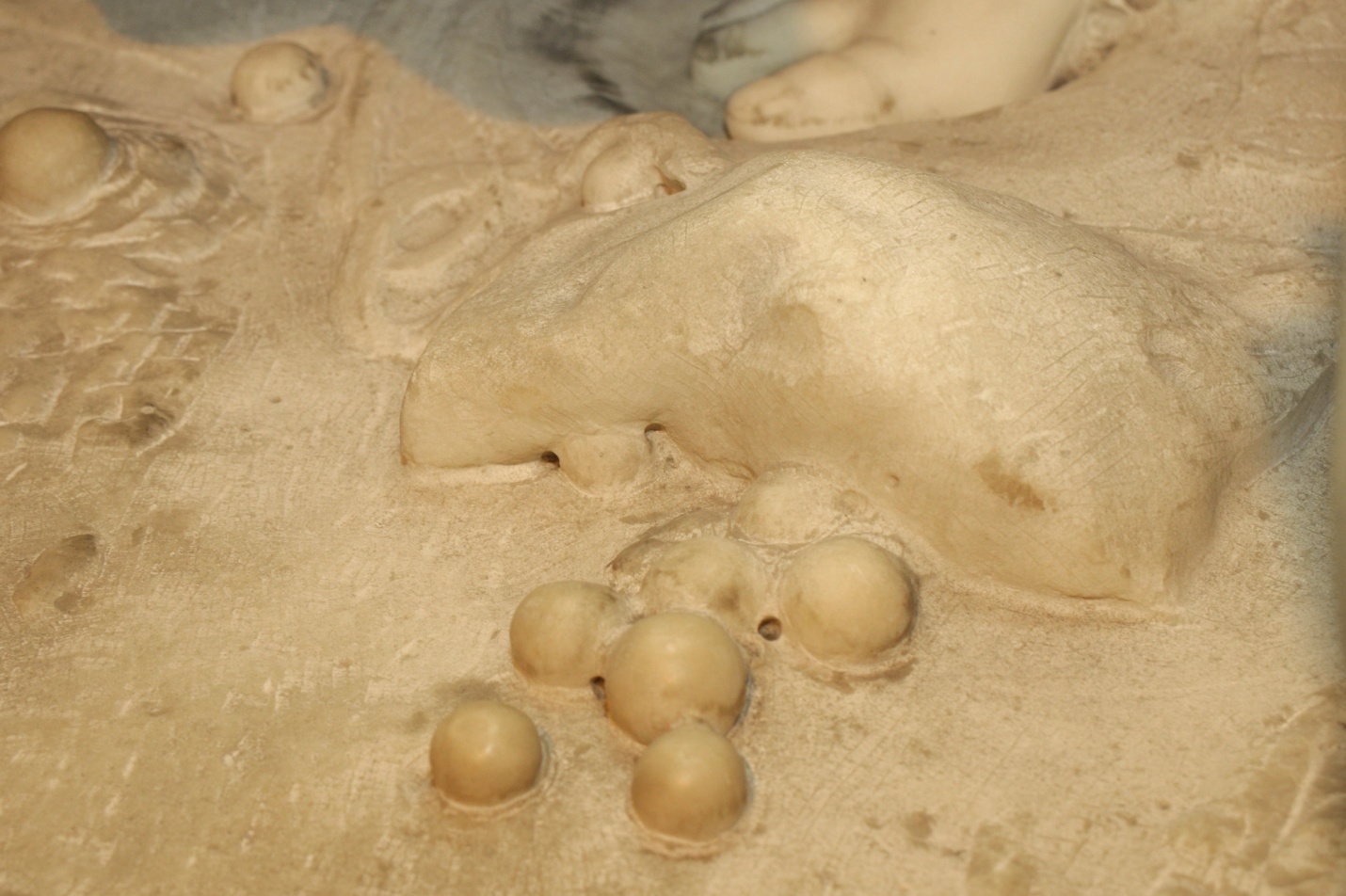 2019.1.50(5) Close up of His marble bag with marbles & has he won five?
2019.1.50(5) Close up of His marble bag with marbles & has he won five?
Detail of Joseph-Louis Enderlin’s art Joueur de Billes (Marble Player)[15]
Christchurch, New Zealand, Uncovered
Christchurch, a city of just over 400,000, is situated on the South Island of New Zealand. In the Blog “Christchurch uncovered (Exploring Christchurch’s past through archaeology) writers present some of the archaeological finds discovered after the earthquakes of 2010 and 2011.
“The artefacts and sites discussed in this blog were excavated during archaeological work carried out as a requirement of either the Historic Places Act 1993 or the Heritage New Zealand Pouhere Taonga Act 2014.”
[The archaeological finds] “…have led to significant discoveries about how people lived in 19th century Christchurch: the food they ate, the medicines they took and the toys children played with.”[16]
The May 2014 story “Archaeology: where losing your marbles is sometimes a good thing”, posted by Jessie Garland, contains a great deal of information about marbles and marble play in 19th century New Zealand. There are also high resolution photographs. One shows both glass and ceramic marbles, and one picture looks exactly like an American industrial (sometimes called railroad) marble.
Child’s Play in the Archaeological Record
Garland’s blog also offers some unique Christchurch insight into the rightful place child’s play in the archaeological and historical records. “Marbles are actually quite rare finds here in Christchurch, surprisingly for something so easily lost.
…The lives of children, especially their lives at play, can be so difficult to see in the archaeological record, making those few marbles we do find as precious to us now as they were to their original owners. We’re beginning to recover quite a variety of different types here in the city as excavations continue, from small clay (earthenware) ‘commies’, to coloured glass marbles and larger earthenware and porcelain examples.”
Hope You Enjoyed This As Much As We Did
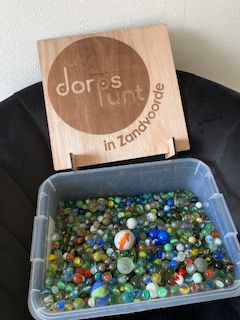 Au revoir, ferdig, Apibendrinant, В заключение, да пабачэння, dat is alles Mensen!, and in Conclusion
Au revoir, ferdig, Apibendrinant, В заключение, да пабачэння, dat is alles Mensen!, and in Conclusion
We learned a lot as we went back over the bits and bobs, the snippets, which we have received over the past several months which focusing on other stories. We are confident of one thing: these snippets give you insight to marble history and mystery which you will find no where else!
We hope that you have enjoyed reading them. One thing that recurs in all these snippets is the conclusion that children, toys like marbles, and spontaneous play, while poorly represented in the archaeological record, have been a linchpin across cultures and history.
Again and again we find that throughout history, in war and peace, in times of political upheaval, exploration and terrible hardship, we find marbles and child’s play time after time. Remember, as W.H. Auden said, “There’s always another story. There’s more than meets the eye.”
- Auteur Joseph-Louis Enderlin; State deposit, transfer of property from the State to the city of Reims, 2019 © Reims, Museum of Fine Arts / photo: C. Devleeschauwer (Dépôt de l’État, transfer de propriété de l’État à la ville de Reims, 2019. An special thanks to Wendy who found this image for us, and to Maryline Begat-Gilson, Service Photo Du Musée des Beaux-arts de Reims chez Ville de Reims for her dedicated and professional services in helping us gain authorization to publish the image. ↑
- Ekaterina Verhees. Ms. Verhees is a Russian journalist, based in Flanders, Belgium, who is the founder and editor of the online magazine Spasibo. Spasibo is intended for those interested in Russia and ex-Soviet states. You might want to check https://spasibo-magazine.com/article/over-ons ↑
- To see more of Enderlin’s work see: https://www.artnet.com , https://fr.wikipedia.org/wiki/ and https://www.invaluable.com/ 10/8/2023 ↑
- You can find comprehensive information on the Lithuanian Republic at https://www.bbc.com/news/world-europe-17536867 10/9/2023 ↑
- https://www.academia.edu/about/ 10/10/2023 ↑
- https://www.academia.edu/6795851/Toys_as_a_reflection_of_players_social_s Online address for the Povilas article “Toys as a reflection of player’s social status” in Academia.edu. You may also be interested in: Blaževičius, Povilas, Ams_Skrifter 23, Socialisation. Recent Research on Childhood and Children in the Past., G. Lillehammer (red.) Stavanger, 2010, p. 95-103; and Blaževičius, Povilas, “Child and childhood in the light of archaeology,” P. Romanowicz (red.) Wrocław, 2012, s. 137-151. ↑
- @ https://worldcurling.org/about/curling/ 9/24/2023↑
- https://en.wikipedia.org/wiki/Saint_Petersburg_State_University 10/11/2023 ↑
- Russian Games (learnrussianineu.com) 10/11/2023 ↑
- You can see Dr. Kurlovich’s impressive list of scholarly papers at Курловіч Паліна Сяргееўна (Курлович П.С., Kurlovich P., Курловіч-Бяляўская П.С., Курлович-Белявская – Google Scholar 10/13/2023 ↑
- https://president.gov.by/en/belarus/regions/vitebskVitebsk Oblast, Belarus | Official Internet Portal of the President of the Republic of Belarus 10/13/2023 ↑
- Курловіч Паліна Сяргееўна (Курлович П.С., Kurlovich P., Курловіч-Бяляўская П.С., Курлович-Белявская – Google Scholar Kurlovich Palina Syargeeina (Kurlovich P.S., Kurlovich P., Kurlovich-Byalyavskaya P.S., Kurlovich-Belyavskaya – Google Scholar https://scholar-google-com.translate.goog/citations?user=t9mgqYgAAAAJ&hl=ru&_x_tr_sl=ru&_x_tr_tl=en&_x_tr_hl=en&_x_tr_pto=sc 10/16/2023 ↑
- 13 One scientific paper explores this topic: PS Kurolovich and Chubur, AA. “The Spread of Guta Glass Production in the XVII –XiX Centuries Based on the Results of the Oikonyms [“Settlements”] of the Uper Dneiper Region and Adjacent Lands.” History: Facts and Symbols. Federal State Budgetary Education Institution of Higher Education “Yelets State University named after IA Bunin” pages 27-45. ↑
- https://www.tvr.by/eng/news/kultura/vpervye_v_belarusi_obnaruzheny_ostatki_steklodelnoy_manufaktury_18_go_veka/ (10/17/2023) There is a remarkable photograph of glass waste at Ilya which, we feel sure, does show glass marbles. Also note Dr. Kurlovich’s use of the word “glass ball.” We explored this same use of the word in our “Searching For Nikolai’s Marbles”
- Auteur Joseph-Louis Enderlin; State deposit, transfer of property from the State to the city of Reims, 2019 © Reims, Museum of Fine Arts / photo: C. Devleeschauwer (Dépôt de l’État, transfer de propriété de l’État à la ville de Reims, 2019. An special thanks to Wendy who found this image for us, and to Maryline Begat-Gilson, Service Photo Du Musée des Beaux-arts de Reims chez Ville de Reims for her dedicated and professional services in helping us gain authorization to publish the image. ↑
- https://blog.underoverarch.co.nz/2014/05/archaeology-where-losing-your-marbles-is-sometimes-a-good-thing/ 10/18/2023 ↑

